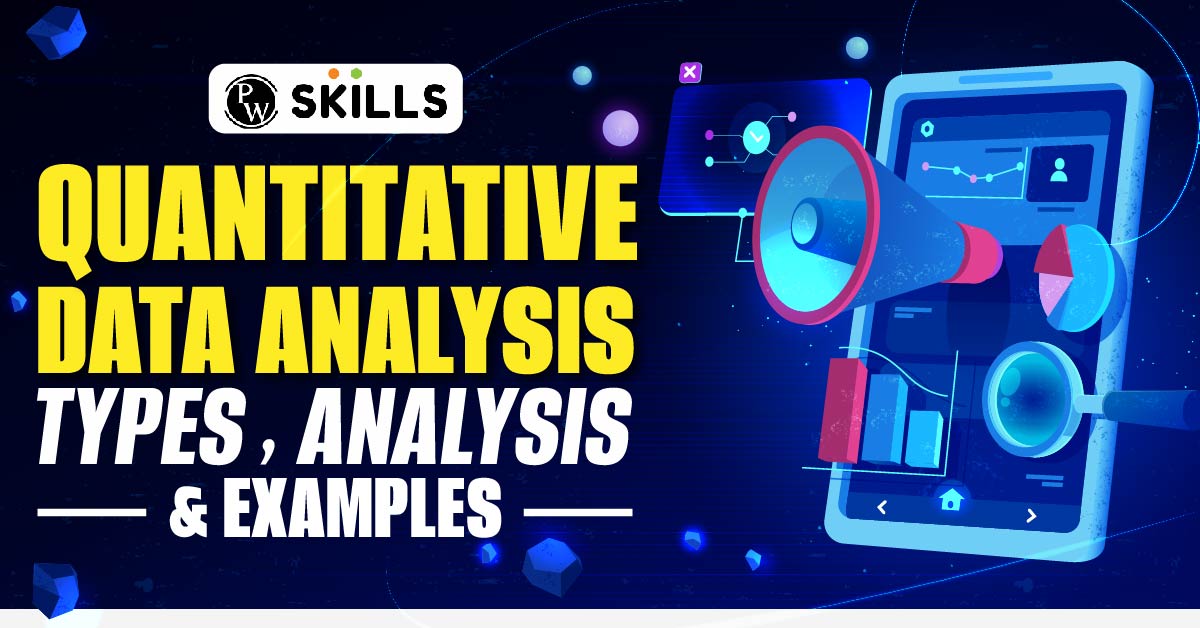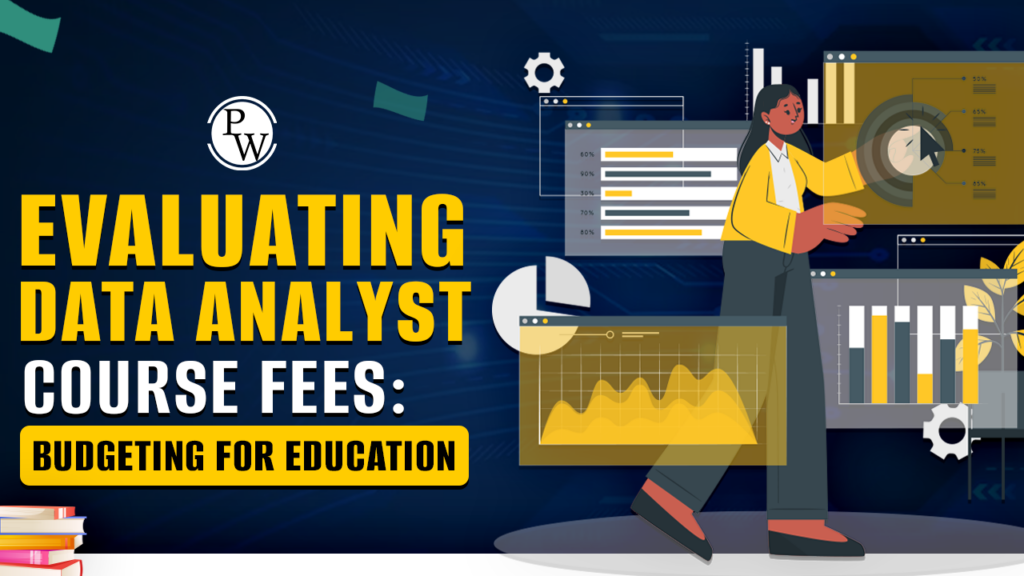Analysis of Quantitative data enables you to transform raw data points, typically organised in spreadsheets, into actionable insights. Refer to the article to know more!
Analysis of Quantitative Data: Data, data everywhere — it’s impossible to escape it in today’s digitally connected world. With business and personal activities leaving digital footprints, vast amounts of quantitative data are being generated every second of every day. While data on its own may seem impersonal and cold, in the right hands it can be transformed into valuable insights that drive meaningful decision-making. In this article, we will discuss analysis of quantitative data types and examples!

If you are looking to acquire hands-on experience in quantitative data analysis, look no further than Physics Wallah’s Data Analytics Course. And as a token of appreciation for reading this blog post until the end, use our exclusive coupon code “READER” to get a discount on the course fee.
What is the Quantitative Analysis Method?
Quantitative Analysis refers to a mathematical approach that gathers and evaluates measurable and verifiable data. This method is utilized to assess performance and various aspects of a business or research. It involves the use of mathematical and statistical techniques to analyze data. Quantitative methods emphasize objective measurements, focusing on statistical, analytical, or numerical analysis of data. It collects data and studies it to derive insights or conclusions.
In a business context, it helps in evaluating the performance and efficiency of operations. Quantitative analysis can be applied across various domains, including finance, research, and chemistry, where data can be converted into numbers for analysis.
Also Read: Analysis vs. Analytics: How Are They Different?
What is the Best Analysis for Quantitative Data?
The “best” analysis for quantitative data largely depends on the specific research objectives, the nature of the data collected, the research questions posed, and the context in which the analysis is conducted. Quantitative data analysis encompasses a wide range of techniques, each suited for different purposes. Here are some commonly employed methods, along with scenarios where they might be considered most appropriate:
1) Descriptive Statistics:
- When to Use: To summarize and describe the basic features of the dataset, providing simple summaries about the sample and measures of central tendency and variability.
- Example: Calculating means, medians, standard deviations, and ranges to describe a dataset.
2) Inferential Statistics:
- When to Use: When you want to make predictions or inferences about a population based on a sample, testing hypotheses, or determining relationships between variables.
- Example: Conducting t-tests to compare means between two groups or performing regression analysis to understand the relationship between an independent variable and a dependent variable.
3) Correlation and Regression Analysis:
- When to Use: To examine relationships between variables, determining the strength and direction of associations, or predicting one variable based on another.
- Example: Assessing the correlation between customer satisfaction scores and sales revenue or predicting house prices based on variables like location, size, and amenities.
4) Factor Analysis:
- When to Use: When dealing with a large set of variables and aiming to identify underlying relationships or latent factors that explain patterns of correlations within the data.
- Example: Exploring underlying constructs influencing employee engagement using survey responses across multiple indicators.
5) Time Series Analysis:
- When to Use: When analyzing data points collected or recorded at successive time intervals to identify patterns, trends, seasonality, or forecast future values.
- Example: Analyzing monthly sales data over several years to detect seasonal trends or forecasting stock prices based on historical data patterns.
6) Cluster Analysis:
- When to Use: To segment a dataset into distinct groups or clusters based on similarities, enabling pattern recognition, customer segmentation, or data reduction.
- Example: Segmenting customers into distinct groups based on purchasing behavior, demographic factors, or preferences.
The “best” analysis for quantitative data is not one-size-fits-all but rather depends on the research objectives, hypotheses, data characteristics, and contextual factors. Often, a combination of analytical techniques may be employed to derive comprehensive insights and address multifaceted research questions effectively. Therefore, selecting the appropriate analysis requires careful consideration of the research goals, methodological rigor, and interpretative relevance to ensure valid, reliable, and actionable outcomes.
Analysis of Quantitative Data in Quantitative Research
Analyzing quantitative data in quantitative research involves a systematic process of examining numerical information to uncover patterns, relationships, and insights that address specific research questions or objectives. Here’s a structured overview of the analysis process:
1) Data Preparation:
- Data Cleaning: Identify and address errors, inconsistencies, missing values, and outliers in the dataset to ensure its integrity and reliability.
- Variable Transformation: Convert variables into appropriate formats or scales, if necessary, for analysis (e.g., normalization, standardization).
2) Descriptive Statistics:
- Central Tendency: Calculate measures like mean, median, and mode to describe the central position of the data.
- Variability: Assess the spread or dispersion of data using measures such as range, variance, standard deviation, and interquartile range.
- Frequency Distribution: Create tables, histograms, or bar charts to display the distribution of values for categorical or discrete variables.
3) Exploratory Data Analysis (EDA):
- Data Visualization: Generate graphical representations like scatter plots, box plots, histograms, or heatmaps to visualize relationships, distributions, and patterns in the data.
- Correlation Analysis: Examine the strength and direction of relationships between variables using correlation coefficients.
4) Inferential Statistics:
- Hypothesis Testing: Formulate null and alternative hypotheses based on research questions, selecting appropriate statistical tests (e.g., t-tests, ANOVA, chi-square tests) to assess differences, associations, or effects.
- Confidence Intervals: Estimate population parameters using sample statistics and determine the range within which the true parameter is likely to fall.
5) Regression Analysis:
- Linear Regression: Identify and quantify relationships between an outcome variable and one or more predictor variables, assessing the strength, direction, and significance of associations.
- Multiple Regression: Evaluate the combined effect of multiple independent variables on a dependent variable, controlling for confounding factors.
6) Factor Analysis and Structural Equation Modeling:
- Factor Analysis: Identify underlying dimensions or constructs that explain patterns of correlations among observed variables, reducing data complexity.
- Structural Equation Modeling (SEM): Examine complex relationships between observed and latent variables, assessing direct and indirect effects within a hypothesized model.
7) Time Series Analysis and Forecasting:
- Trend Analysis: Analyze patterns, trends, and seasonality in time-ordered data to understand historical patterns and predict future values.
- Forecasting Models: Develop predictive models (e.g., ARIMA, exponential smoothing) to anticipate future trends, demand, or outcomes based on historical data patterns.
8) Interpretation and Reporting:
- Interpret Results: Translate statistical findings into meaningful insights, discussing implications, limitations, and conclusions in the context of the research objectives.
- Documentation: Document the analysis process, methodologies, assumptions, and findings systematically for transparency, reproducibility, and peer review.
Also Read: Learning Path to Become a Data Analyst in 2024
Analysis of Quantitative Data Examples
Analyzing quantitative data involves various statistical methods and techniques to derive meaningful insights from numerical data. Here are some examples illustrating the analysis of quantitative data across different contexts:
| Analysis of Quantitative Data Examples | ||
| Statistical Technique | Example | Application Context |
| Descriptive Statistics | Calculating mean, median, mode, range of students’ scores on a mathematics exam | Educational Assessment |
| Exploratory Data Analysis | Creating histograms to visualize monthly sales data for a retail business | Business Analytics |
| Correlation Analysis | Examining correlation between advertising expenditure and product sales revenue | Marketing and Sales |
| Hypothesis Testing | Conducting t-test to compare mean scores of control and treatment groups | Scientific Research |
| Regression Analysis | Performing linear regression to predict housing prices based on property features | Real Estate Market |
| Factor Analysis | Utilizing factor analysis to identify underlying constructs from customer survey responses | Market Research |
| Time Series Analysis | Analyzing stock market data to identify trends and forecast future stock prices | Financial Analysis |
| Chi-Square Test | Conducting chi-square test to examine relationship between gender and voting preferences | Political Science |
| ANOVA (Analysis of Variance) | Performing ANOVA to determine differences in mean scores across multiple teaching methods | Educational Research |
| Cluster Analysis | Applying K-means clustering to segment customers based on purchasing behavior | Customer Segmentation and Marketing |
How to Write Data Analysis in Quantitative Research Proposal?
Writing the data analysis section in a quantitative research proposal requires careful planning and organization to convey a clear, concise, and methodologically sound approach to analyzing the collected data. Here’s a step-by-step guide on how to write the data analysis section effectively:
Step 1: Begin with an Introduction
- Contextualize: Briefly reintroduce the research objectives, questions, and the significance of the study.
- Purpose Statement: Clearly state the purpose of the data analysis section, outlining what readers can expect in this part of the proposal.
Step 2: Describe Data Collection Methods
- Detail Collection Techniques: Provide a concise overview of the methods used for data collection (e.g., surveys, experiments, observations).
- Instrumentation: Mention any tools, instruments, or software employed for data gathering and its relevance.
Step 3: Discuss Data Cleaning Procedures
- Data Cleaning: Describe the procedures for cleaning and pre-processing the data.
- Handling Outliers & Missing Data: Explain how outliers, missing values, and other inconsistencies will be managed to ensure data quality.
Step 4: Present Analytical Techniques
- Descriptive Statistics: Outline the descriptive statistics that will be calculated to summarize the data (e.g., mean, median, mode, standard deviation).
- Inferential Statistics: Specify the inferential statistical tests or models planned for deeper analysis (e.g., t-tests, ANOVA, regression).
Step 5: State Hypotheses & Testing Procedures
- Hypothesis Formulation: Clearly state the null and alternative hypotheses based on the research questions or objectives.
- Testing Strategy: Detail the procedures for hypothesis testing, including the chosen significance level (e.g., α = 0.05) and statistical criteria.
Step 6: Provide a Sample Analysis Plan
- Step-by-Step Plan: Offer a sample plan detailing the sequence of steps involved in the data analysis process.
- Software & Tools: Mention any specific statistical software or tools that will be utilized for analysis.
Step 7: Address Validity & Reliability
- Validity: Discuss how you will ensure the validity of the data analysis methods and results.
- Reliability: Explain measures taken to enhance the reliability and replicability of the study findings.
Step 8: Discuss Ethical Considerations
- Ethical Compliance: Address ethical considerations related to data privacy, confidentiality, and informed consent.
- Compliance with Guidelines: Ensure that your data analysis methods align with ethical guidelines and institutional policies.
Step 9: Acknowledge Limitations
- Limitations: Acknowledge potential limitations in the data analysis methods or data set.
- Mitigation Strategies: Offer strategies or alternative approaches to mitigate identified limitations.
Step 10: Conclude the Section
- Summary: Summarize the key points discussed in the data analysis section.
- Transition: Provide a smooth transition to subsequent sections of the research proposal, such as the conclusion or references.
Step 11: Proofread & Revise
- Review: Carefully review the data analysis section for clarity, coherence, and consistency.
- Feedback: Seek feedback from peers, advisors, or mentors to refine your approach and ensure methodological rigor.
What are the 4 Types of Quantitative Analysis?
Quantitative analysis encompasses various methods to evaluate and interpret numerical data. While the specific categorization can vary based on context, here are four broad types of quantitative analysis commonly recognized:
- Descriptive Analysis: This involves summarizing and presenting data to describe its main features, such as mean, median, mode, standard deviation, and range. Descriptive statistics provide a straightforward overview of the dataset’s characteristics.
- Inferential Analysis: This type of analysis uses sample data to make predictions or inferences about a larger population. Techniques like hypothesis testing, regression analysis, and confidence intervals fall under this category. The goal is to draw conclusions that extend beyond the immediate data collected.
- Time-Series Analysis: In this method, data points are collected, recorded, and analyzed over successive time intervals. Time-series analysis helps identify patterns, trends, and seasonal variations within the data. It’s particularly useful in forecasting future values based on historical trends.
- Causal or Experimental Research: This involves establishing a cause-and-effect relationship between variables. Through experimental designs, researchers manipulate one variable to observe the effect on another variable while controlling for external factors. Randomized controlled trials are a common method within this type of quantitative analysis.
Each type of quantitative analysis serves specific purposes and is applied based on the nature of the data and the research objectives.
Also Read: AI and Predictive Analytics: Examples, Tools, Uses, Ai Vs Predictive Analytics
Steps to Effective Quantitative Data Analysis
Quantitative data analysis need not be daunting; it’s a systematic process that anyone can master. To harness actionable insights from your company’s data, follow these structured steps:
Step 1: Gather Data Strategically
Initiating the analysis journey requires a foundation of relevant data. Employ quantitative research methods to accumulate numerical insights from diverse channels such as:
- Interviews or Focus Groups: Engage directly with stakeholders or customers to gather specific numerical feedback.
- Digital Analytics: Utilize tools like Google Analytics to extract metrics related to website traffic, user behavior, and conversions.
- Observational Tools: Leverage heatmaps, click-through rates, or session recordings to capture user interactions and preferences.
- Structured Questionnaires: Deploy surveys or feedback mechanisms that employ close-ended questions for precise responses.
Ensure that your data collection methods align with your research objectives, focusing on granularity and accuracy.
Step 2: Refine and Cleanse Your Data
Raw data often comes with imperfections. Scrutinize your dataset to identify and rectify:
- Errors and Inconsistencies: Address any inaccuracies or discrepancies that could mislead your analysis.
- Duplicates: Eliminate repeated data points that can skew results.
- Outliers: Identify and assess outliers, determining whether they should be adjusted or excluded based on contextual relevance.
Cleaning your dataset ensures that subsequent analyses are based on reliable and consistent information, enhancing the credibility of your findings.
Step 3: Delve into Analysis with Precision
With a refined dataset at your disposal, transition into the analytical phase. Employ both descriptive and inferential analysis techniques:
- Descriptive Analysis: Summarize key attributes of your dataset, computing metrics like averages, distributions, and frequencies.
- Inferential Analysis: Leverage statistical methodologies to derive insights, explore relationships between variables, or formulate predictions.
The objective is not just number crunching but deriving actionable insights. Interpret your findings to discern underlying patterns, correlations, or trends that inform strategic decision-making. For instance, if data indicates a notable relationship between user engagement metrics and specific website features, consider optimizing those features for enhanced user experience.
Step 4: Visual Representation and Communication
Transforming your analytical outcomes into comprehensible narratives is crucial for organizational alignment and decision-making. Leverage visualization tools and techniques to:
- Craft Engaging Visuals: Develop charts, graphs, or dashboards that encapsulate key findings and insights.
- Highlight Insights: Use visual elements to emphasize critical data points, trends, or comparative metrics effectively.
- Facilitate Stakeholder Engagement: Share your visual representations with relevant stakeholders, ensuring clarity and fostering informed discussions.
Tools like Tableau, Power BI, or specialized platforms like Hotjar can simplify the visualization process, enabling seamless representation and dissemination of your quantitative insights.
Also Read: Top 10 Must Use AI Tools for Data Analysis [2024 Edition]
Statistical Analysis in Quantitative Research
Statistical analysis is a cornerstone of quantitative research, providing the tools and techniques to interpret numerical data systematically. By applying statistical methods, researchers can identify patterns, relationships, and trends within datasets, enabling evidence-based conclusions and informed decision-making. Here’s an overview of the key aspects and methodologies involved in statistical analysis within quantitative research:
1) Descriptive Statistics:
- Mean, Median, Mode: Measures of central tendency that summarize the average, middle, and most frequent values in a dataset, respectively.
- Standard Deviation, Variance: Indicators of data dispersion or variability around the mean.
- Frequency Distributions: Tabular or graphical representations that display the distribution of data values or categories.
2) Inferential Statistics:
- Hypothesis Testing: Formal methodologies to test hypotheses or assumptions about population parameters using sample data. Common tests include t-tests, chi-square tests, ANOVA, and regression analysis.
- Confidence Intervals: Estimation techniques that provide a range of values within which a population parameter is likely to lie, based on sample data.
- Correlation and Regression Analysis: Techniques to explore relationships between variables, determining the strength and direction of associations. Regression analysis further enables prediction and modeling based on observed data patterns.
3) Probability Distributions:
- Normal Distribution: A bell-shaped distribution often observed in naturally occurring phenomena, forming the basis for many statistical tests.
- Binomial, Poisson, and Exponential Distributions: Specific probability distributions applicable to discrete or continuous random variables, depending on the nature of the research data.
4) Multivariate Analysis:
- Factor Analysis: A technique to identify underlying relationships between observed variables, often used in survey research or data reduction scenarios.
- Cluster Analysis: Methodologies that group similar objects or individuals based on predefined criteria, enabling segmentation or pattern recognition within datasets.
- Multivariate Regression: Extending regression analysis to multiple independent variables, assessing their collective impact on a dependent variable.
5) Data Modeling and Forecasting:
- Time Series Analysis: Analyzing data points collected or recorded at specific time intervals to identify patterns, trends, or seasonality.
- Predictive Analytics: Leveraging statistical models and machine learning algorithms to forecast future trends, outcomes, or behaviors based on historical data.
If this blog post has piqued your interest in the field of data analytics, then we highly recommend checking out Physics Wallah’s Data Analytics Course. This course covers all the fundamental concepts of quantitative data analysis and provides hands-on training for various tools and software used in the industry.
With a team of experienced instructors from different backgrounds and industries, you will gain a comprehensive understanding of a wide range of topics related to data analytics. And as an added bonus for being one of our dedicated readers, use the coupon code “READER” to get an exclusive discount on this course!
For Latest Tech Related Information, Join Our Official Free Telegram Group : PW Skills Telegram Group
Analysis of Quantitative Data FAQs
What is quantitative data analysis?
Quantitative data analysis involves the systematic process of collecting, cleaning, interpreting, and presenting numerical data to identify patterns, trends, and relationships through statistical methods and mathematical calculations.
What are the main steps involved in quantitative data analysis?
The primary steps include data collection, data cleaning, statistical analysis (descriptive and inferential), interpretation of results, and visualization of findings using graphs or charts.
What is the difference between descriptive and inferential analysis?
Descriptive analysis summarizes and describes the main aspects of the dataset (e.g., mean, median, mode), while inferential analysis draws conclusions or predictions about a population based on a sample, using statistical tests and models.
How do I handle outliers in my quantitative data?
Outliers can be managed by identifying them through statistical methods, understanding their nature (error or valid data), and deciding whether to remove them, transform them, or conduct separate analyses to understand their impact.
Which statistical tests should I use for my quantitative research?
The choice of statistical tests depends on your research design, data type, and research questions. Common tests include t-tests, ANOVA, regression analysis, chi-square tests, and correlation analysis, among others.




